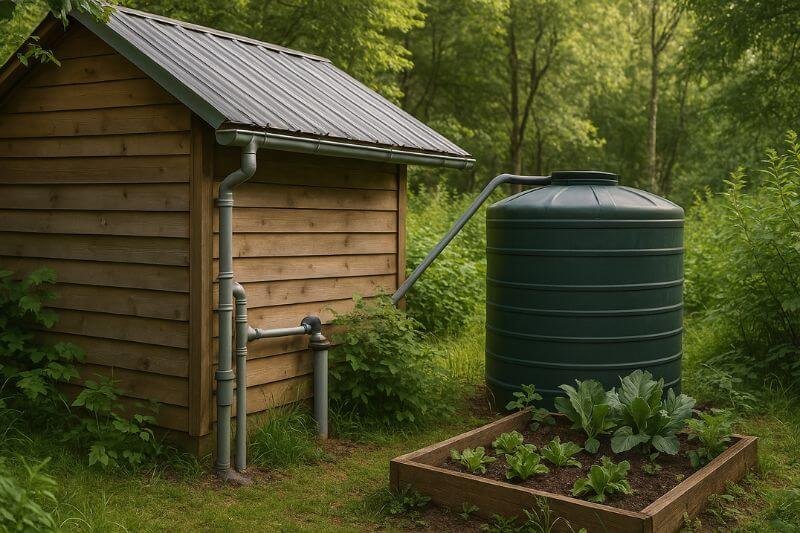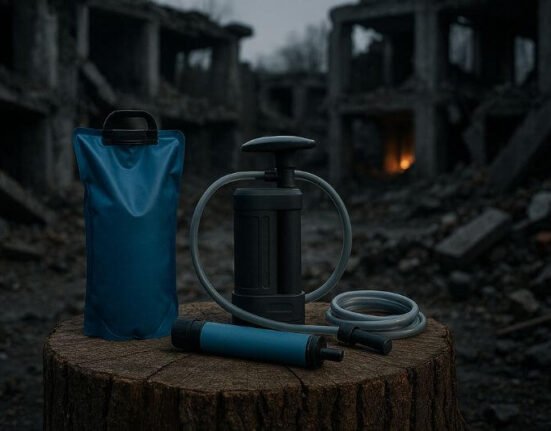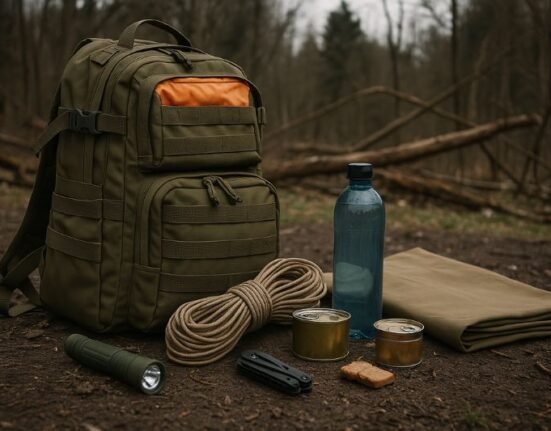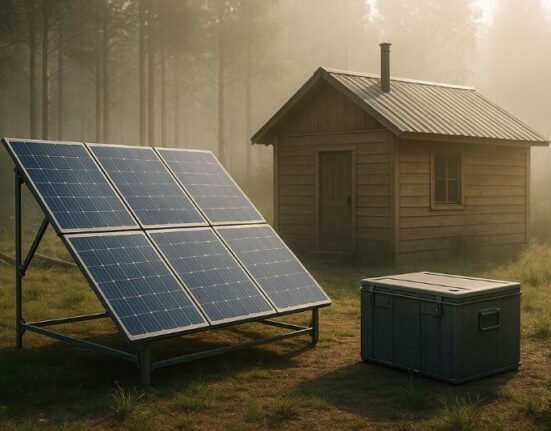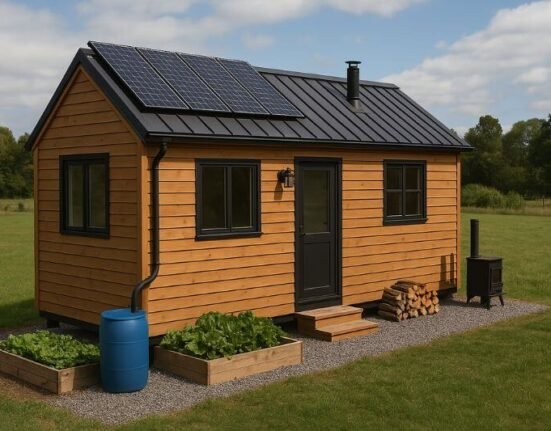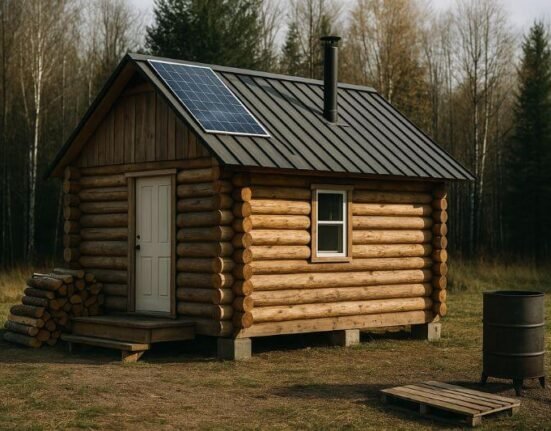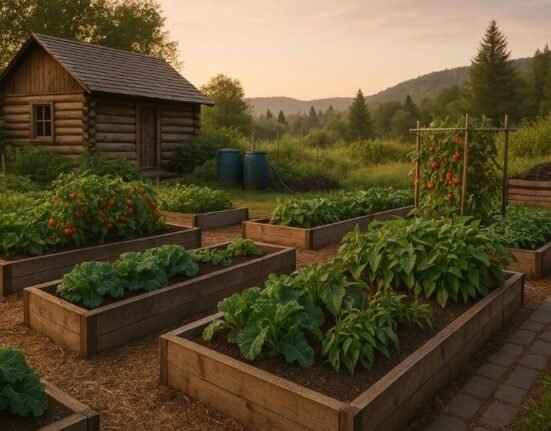When you cut ties with municipal systems, your survival hinges on one question: Where will your water come from?
For most off-grid homesteads, bug-out locations, or long-term survival setups, the answer lies above you — in the rain.
Rainwater harvesting off-grid isn’t a luxury. It’s a foundational system that determines whether you can wash, grow, clean, and survive. Done right, it provides clean, renewable, and passive water access all year. Done wrong, it leads to bacterial risk, supply shortfalls, or outright system failure.
“Without water, you last 3 days. With rainwater harvesting, you last a lifetime.”
Let’s break down how to build a smart, self-sustaining rainwater system for true independence.
🌧️ Part 1: Understanding Rainwater as a Survival Resource
🌍 Why Rainwater Is Your Most Reliable Source Off-Grid
Most off-grid survivalists rely on three water options:
- Well water (if you own land and can dig deep)
- Surface water (streams, ponds — often unreliable or contaminated)
- Rainwater harvesting (passive, decentralized, and safe when treated properly)
Advantages of rainwater harvesting:
- ✅ No fuel dependency (unlike pumped wells)
- ✅ Renewable and seasonal — ideal in temperate or tropical zones
- ✅ Low infrastructure cost — no digging, permits, or pumping needed
- ✅ Easier to filter and purify than surface water
- ✅ Flexible — scale from 50L to 10,000L depending on roof size and tank capacity
💬 Even in semi-arid regions, with proper design, you can collect tens of thousands of liters per year — enough for drinking, cooking, bathing, and crops.
📏 How Much Rain Can You Actually Harvest?
Let’s look at the math.
🧮 The basic formula:
Catchment Area (m²) × Rainfall (mm/year) × 0.9 = Liters/year
- A 20 m² roof in a 500 mm rainfall zone =
→ 20 × 500 × 0.9 = 9,000 liters/year - A 100 m² roof in a 900 mm zone =
→ 100 × 900 × 0.9 = 81,000 liters/year
That’s over 200 liters per day — more than enough for a small household with efficient usage.
💡 The key is not just collecting rain, but storing and protecting it.
🏠 Components of a Basic Off-Grid Rainwater System
| Component | Function |
|---|---|
| Roof catchment | Captures rain (metal or tile preferred) |
| Gutter system | Channels water toward storage |
| First flush diverter | Removes initial contaminants (dust, bird droppings) |
| Filter | Removes debris, sand, and particulates |
| Storage tank | Holds water (barrels, IBCs, cisterns) |
| Purification unit | Final treatment (UV, charcoal, ceramic, etc.) |
We’ll break these down in more detail in Part 2.
🔎 What Makes a Roof “Harvest-Ready”?
Not all roofs are created equal. Some can harvest clean water. Others leach chemicals, bird waste, or roofing compounds.
✅ Best materials:
- Corrugated metal (galvanized or painted)
- Clay or terracotta tiles
- Food-safe polycarbonate roofing
⚠️ Avoid:
- Asphalt shingles (can contain tar and toxic run-off)
- Wooden shingles (mold and insect contamination)
- Green roofs (absorbent, inefficient for harvesting)
💡 If you’re building off-grid from scratch, design the roof first — it becomes your primary water source.
💀 Rainwater Risks If You Get It Wrong
Let’s be clear: rainwater itself is not sterile. And once it hits your roof, it becomes biologically active.
☣️ Common dangers:
- Bird droppings → E. coli or cryptosporidium
- Mold spores from trees → lung irritation
- Roof contaminants → heavy metal leaching
- Standing water in barrels → mosquito larvae
“Rain is clean. Roof runoff is not. Always treat before drinking.”
We’ll discuss treatment methods — simple and advanced — in Part 3.
🧠 The Psychology of Water Scarcity
Ask anyone who has lived off-grid through a drought: running out of water is not a joke.
Symptoms of water scarcity in off-grid living:
- Rationing hygiene
- Limiting cooking options
- Stress or tension in households
- Difficulty managing livestock or crops
- Increased illness from using unfiltered water
Survivalists don’t just prepare food — they design their lives around water security.
“When you manage your water right, everything else becomes easier.”
📉 Real-World Example: Failure in the Pacific Northwest
An off-grid family in Washington State relied on a metal roof, 2 barrels, and no filtration.
Here’s what went wrong:
- First flush diverter wasn’t installed — so every rainfall brought debris into the tank.
- Tanks were unsealed — mosquito larvae developed
- No overflow system — flooding eroded the base
- They assumed UV treatment wasn’t needed because “rain is clean”
Result? Gastroenteritis outbreak, abandoned tanks, and a $1,200 rebuild.
💡 Lesson: A rain system doesn’t need to be fancy — just well thought out.
🛠️ Part 2: Building Your Off-Grid Rainwater Harvesting System
🔧 System Overview – From Roof to Tap
The key to rainwater harvesting off-grid is not just catching the water — it’s directing, filtering, storing, and purifying it without wasting a drop.
Here’s the full journey of a rain drop:
Roof → Gutter → First Flush Diverter → Filter → Storage Tank → Purification → Taps
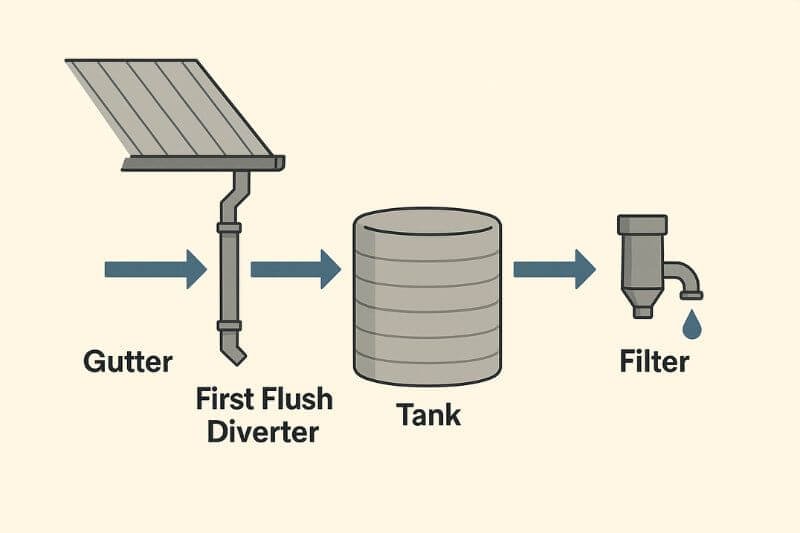
Each link in that chain matters. Let’s break it down.
🏠 1. Catchment Area (Your Roof)
Your roof is your water collector — so it must be:
- Clean, non-toxic
- Free of overhanging trees
- Sloped for good runoff
- Fitted with gutters that don’t leak or clog
📐 Optimization Tips:
- Install leaf guards or mesh screens
- Seal roof gaps to avoid wildlife contamination
- Apply food-safe coatings if using painted metal
💡 Tip: Paint roof areas with reflective white to reduce temperature and algae in tanks.
🌀 2. First Flush Diverter
The first 10–20 liters of every rainfall carry the worst contamination: dust, bird droppings, pollen, and roof toxins.
✅ Diverter functions:
- Automatically discards the first flow of rain
- Prevents contaminated water from reaching your storage tank
- Resets with every rain
Simple DIY versions:
- Vertical pipe with a ball-float valve
- Flip bucket design
- Drain valve with timer release
“If you don’t flush the first water, you’re drinking what birds leave behind.”
🧹 3. Filtration Systems
Before the water hits your tank, it must pass through a sediment and debris filter. This doesn’t make it drinkable — but it keeps your tank clean and your pump unclogged.
Filter types:
| Filter Type | Placement | Removes |
|---|---|---|
| Leaf basket | At gutter entry | Leaves, large debris |
| Mesh screen | After diverter | Sand, grit, dust |
| Sediment filter | Before storage | Fine particles |
💡 Combine filters in layers. Never rely on one.
🛢️ 4. Water Storage Tanks
Storage is survival. You can’t harvest what you don’t store.
Tank options:
- Plastic food-grade barrels (55–100 gallons)
Affordable and modular - IBC totes (275 gallons)
Stackable, durable, UV-resistant - Underground cisterns (1000+ gallons)
High-volume, protects from light and freezing - Concrete or ferrocement tanks
Built-in-place, ideal for permanent setups
Tank placement tips:
- Shade tanks or use dark-colored plastic to reduce algae
- Elevate tanks for gravity-fed pressure
- Add overflow pipe with a screened outlet
- Secure all lids (insects, rodents, and kids are curious)
💡 You’ll always wish you had a bigger tank. Plan accordingly.
💦 5. Pressure & Flow
Off-grid doesn’t mean low pressure. A good system delivers water to your sink, shower, or garden — naturally or with assistance.
3 pressure options:
- Gravity-fed (1m = 0.1 bar pressure)
Simple, reliable, low volume - 12V pump (solar or battery-powered)
Boosts pressure, supports showers and appliances - Hand pump backup
Always have a manual plan B
💡 Use a pressure switch to automate pump on/off cycles.
🧪 6. Final Water Purification
This is where you make your rainwater drinkable. Harvesting is only half the equation — treatment is the other.
Options by level:
| Method | Removes | Ideal For |
|---|---|---|
| Ceramic filters | Bacteria, protozoa | Daily drinking |
| Activated charcoal | Taste, chlorine, organic compounds | Household use |
| UV light | Viruses, bacteria | Final disinfection (needs power) |
| Boiling | Everything biological | Emergency or daily use |
| Biosand filter | Wide-spectrum filtration | Low-tech, long-term solutions |
“Clear water is not clean water. Always purify before drinking.”
🧊 Cold Weather Adaptation
Rainwater systems can freeze and fail in winter without preparation.
❄️ Winter-proofing steps:
- Insulate above-ground tanks or move them indoors
- Bury pipes or wrap with foam sleeves
- Use dark-colored barrels to absorb solar heat
- Add drain valves for system blowout before freeze
💡 In extreme climates, switch to snow melt + filtration as a fallback.
📉 Common Setup Mistakes (and Fixes)
| Mistake | Consequence | Fix |
|---|---|---|
| No first flush diverter | Contaminated tank water | Install simple diverter |
| Plastic barrels exposed to light | Algae bloom | Use opaque or shaded containers |
| Overflow outlet missing | Tank erosion or flooding | Add screened overflow pipe |
| No purification after filter | Illness from bacteria | Add UV, boil, or ceramic filter |
| Pipes freeze in winter | No flow, pipe burst | Insulate or bury lines |
🌿 Part 3: Real-World Resilience – Maintaining, Adapting & Maximizing Your System
🔧 Real-World Rainwater Harvesting in Action
Theory is nothing without real-world application. Let’s look at how survivalists, preppers, and off-grid communities successfully use rainwater systems long-term.
🏕️ Case Study 1: Bug-Out Cabin in Appalachia
- 100 m² metal roof → ~80,000 L/year
- 2 x IBC totes (550 gallons) gravity-fed
- First flush system built from PVC pipe
- Drinking water: ceramic filter + charcoal
Outcome: Fully self-reliant for two adults. Cost: under $1,000.
🛖 Case Study 2: Desert Homestead in Arizona
- 40 m² polycarbonate roof
- First flush + dual sediment filters
- Underground 2000-gallon cistern
- Fog net added for morning dew
- Boil + UV lamp for final purification
Outcome: Reliable water even with <300mm annual rainfall.
“The system doesn’t need to be expensive — it needs to be appropriate for your climate and usage.”
🧰 Maintenance = Survival
Most rainwater systems fail not from design — but from neglect.
🗓️ Monthly Maintenance Checklist:
- ✅ Check and clean gutters
- ✅ Flush diverter and debris filters
- ✅ Inspect for leaks or overflowing tanks
- ✅ Clean tank lids and vents
- ✅ Check water clarity and smell
🧪 Seasonal Tasks:
- Before rainy season: clean roof and flush tanks
- Before winter: drain exposed lines or insulate
- Every 6 months: replace filters, test water for bacteria
“A neglected rain system is a liability. A maintained system is a lifesaver.”
🌵 Low Rainfall Strategies
If you live in a dry or semi-arid region, rainwater harvesting off-grid is still viable — with planning.
🌞 Maximize every drop:
- Use larger roof surfaces: greenhouse roofs, sheds, patios
- Connect multiple tanks in series
- Implement first flush only during first rain of the season
- Install underground or shaded tanks to prevent evaporation
☁️ Bonus strategies:
- Use fog nets in coastal or misty zones
- Divert greywater (from shower or sink) to irrigation
- Use mulch basins to reduce watering needs
💡 Consider rain gardens that absorb overflow and recharge soil.
🧠 Water Psychology Off-Grid
Living with limited water changes how you think, behave, and build community.
Survival households report:
- Bathing with 1L of water
- Washing dishes with greywater reuse
- Prioritizing drinking and irrigation
- Deep respect for every drop
“Water scarcity doesn’t just change systems — it changes people.”
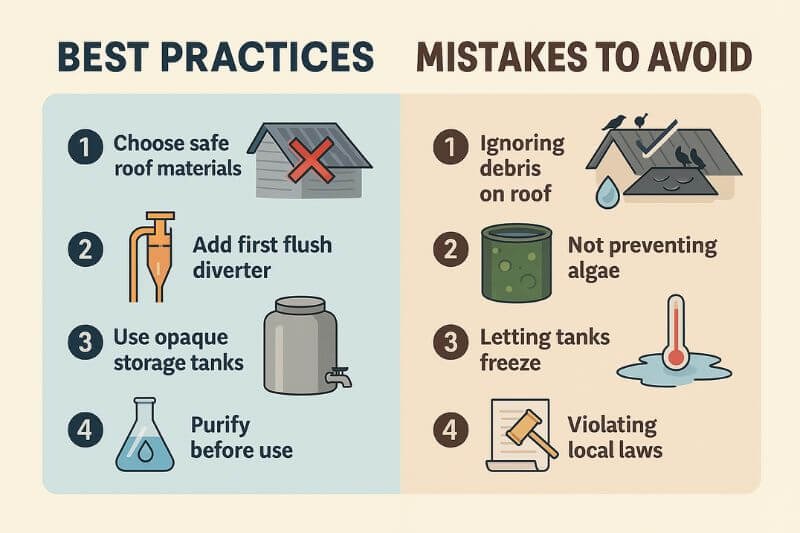
🌎 Legal, Zoning & Local Considerations
Rainwater harvesting is legal in most countries, but some places restrict large-scale storage or require permits.
🇺🇸 U.S. Example:
- Texas: Legal and encouraged; some tax incentives
- Colorado: Previously restricted, now allows up to 110 gallons
- California: Legal for non-potable use, may require permits
📝 Always check:
- Water rights and collection limits
- Storage regulations (especially underground tanks)
- Greywater discharge laws
💡 Pro Tip: In remote regions, you may not need permits — but keeping your system modular and low-profile avoids issues.
❓ Frequently Asked Questions (FAQ) – Rainwater Harvesting Off-Grid
Q: Is rainwater harvesting legal everywhere?
No — and that surprises many off-gridders.
While rain is free, the right to collect it isn’t universal. In some jurisdictions, especially in areas with water scarcity or complex water rights laws, there may be restrictions or regulations around rainwater collection.
🧭 How the law varies:
- Most rural areas allow full rainwater harvesting without a permit.
- In the U.S., states like Texas encourage it — even offering tax incentives.
- Colorado previously prohibited rainwater collection; now it allows up to 110 gallons for residential use.
- In Australia, Germany, and New Zealand, rainwater systems are widespread and often subsidized.
✅ What to do:
- Check your county or municipality regulations
- Look for zoning restrictions on tank size, location, or use case (drinking vs irrigation)
- If needed, label systems as “non-potable” to avoid permit complications
“You may own the roof — but not the rain. Know the law before building your system.”
Q: Can I drink rainwater directly from my roof?
Not safely.
Rainfall itself is relatively clean, but once it hits your roof, it picks up pollutants, organic waste, and chemical residue.
🚫 What might be in that water:
- Bird droppings = E. coli, cryptosporidium, salmonella
- Pollen and leaves = organic sludge and biofilm growth
- Roof materials = lead, asphalt residue, pesticides from nearby trees
✅ Always follow the Three-Step Rule:
- First flush — discard the first few liters of each rain
- Filter — use physical sediment filters to remove debris
- Purify — boil, UV treat, or use ceramic/charcoal filters
💡 Don’t just “boil and hope” — build a layered purification process.
“Just because it’s clear doesn’t mean it’s clean.”
Q: What if I live in a desert or dry zone?
You can still use rainwater harvesting off-grid — but every drop must be planned and preserved.
✅ Desert strategies that work:
- Oversize your catchment: use metal roofs, greenhouses, or even tarps
- Install underground or shaded tanks: prevents evaporation
- Capture morning condensation with fog nets (fine mesh stretched between posts)
- Combine with greywater reuse for plants
📊 Example:
A 40m² roof in a region with 250mm annual rainfall can still yield:
40 × 250 × 0.9 = 9,000 liters per year
That’s 24 liters per day — enough for two people with efficient usage.
💡 Bonus Tip: Dig a rain garden basin lined with gravel to trap flash floods and guide them into your tank.
“In the desert, your system isn’t a backup — it’s your only chance.”
Q: Is algae in my tank dangerous?
Yes — and it’s often overlooked.
Algae growth in rainwater tanks indicates sunlight penetration and stagnation, which can lead to bacterial proliferation and rotten odor.
🚫 Risks from algae:
- Creates slippery, oxygen-depleting biofilms
- Harbors bacteria and protozoa
- Blocks filters and pumps
- Causes foul taste and smell
✅ Prevention steps:
- Use dark-colored, opaque tanks (black, green, or buried)
- Store tanks in shade or build a sun shelter
- Keep all lids sealed, and screen vents and overflow pipes
- Clean tanks every 6–12 months
💡 Natural fix: Add a cup of food-grade hydrogen peroxide to small tanks (under 300L) to oxidize biofilm without chemical contamination.
“If your tank’s green, your water’s not clean.”
✅ Conclusion: Catch It, Store It, Protect It
Rain is your most overlooked ally in off-grid living.
When systems fail, when wells dry up, when taps go silent — your ability to harvest and purify water from the sky may decide everything.
Rainwater harvesting off-grid is not a backup plan.
It’s your first line of resilience.
“You don’t need rain every day. You just need to be ready when it comes.”









